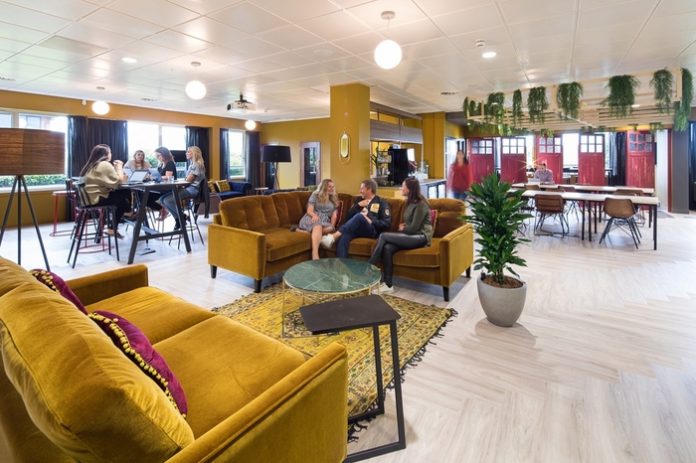Cyril Parsons, joint managing director and co-founder of award-winning design and workplace consultancy, Office Principles, looks at how the office is now expected to provide an ‘experience’ for its inhabitants to keep them happy and engaged.
The office as a work location has changed. We’ve entered an age where a lot of office workers, unlike manufacturing and public sector workers, don’t need to be present in order to fulfil their duties, which means we have to rethink the physical space in order for it to remain relevant.
Many of us simply don’t need to be present in the office anymore. We can work independently, in any number of alternative locations; as long as we have access to wi-fi and a laptop, we’re good to go.
We don’t have to justify our time away, either. Our digital workings leave their own trail and so there is proof that we are doing our jobs and still delivering – which is essentially, the main criteria.
The flip side is that this means the office has to work very hard to draw us in. Employees need to be enticed into the workplace and provided with good reason to put in an appearance. The office must deliver an experience that is preferable to us basing ourselves at home – or, indeed, anywhere else.
In short, it has to present itself as more enjoyable, worthy and worthwhile; offering an experience that can’t be accessed elsewhere.
The forerunners
Creating an experience for the end-user is not a new phenomenon.
The ‘retail experience’ was evident almost twenty years ago, taking on a life of its own, with shopping centres and high streets fighting hard to lessen the impact of the ecommerce onslaught and to maintain a healthy footfall.
This sector was the first to acknowledge that it had to raise its game, by providing shoppers with a full experience and, effectively, keeping them entertained.
Over the years, we’ve seen orchestras playing in the centre of malls; impromptu fashion shows and bands performing in retail parks; children’s entertainment on the High Street; cooking, makeover demos and celebrity appearances in department stores; and streets transformed with sand and astro turf across cities and towns.
What was once exceptional event shopping has become a more regular happening and now every significant date on the retail calendar is bound to be transformed into an experience, each getting bigger and better depending on the brand and its budget.
Leisure has followed suit and often combines with retail to offer a bigger and better experience. Now, out of town shared retail and leisure locations have become destinations because they deliver on more than just one front, combining shopping, food, sport and entertainment.
Many of these centres are now dabbling with the gamification of a lot of their leisure points to create a truly immersive experience. The larger destinations also have hotel chains tagged on, which arguably dispels the need to go home and prolongs the overall experience.
So where does the workplace fit in to this chain?
How the workplace makes us feel
At a Workplace Trends event, which took place last year, many of the speakers referenced a common theme – making the workplace a human centric environment. Global head of research for JLL Corporate Solutions, Marie Puybaraud talked of three specific priorities: ‘Engagement’ – ensuring that staff are committed and therefore loyal to the company; ‘Empowerment’ – providing staff with a sense of being in control of their work and outcomes; ‘Fulfilment’ – giving individuals the means to take comfort in their working environment.
We’re certainly moving on from measuring the value of office space against total occupancy costs and the utilisation of spaces and instead, along with health and wellbeing, considering employee fulfilment and happiness levels.
Creative spaces and comfort levels are now common to most functional and more forward-thinking plans.
Sharing space
The big corporates are ahead of the game and have been working towards building the employees’ experience for some time, catering for every want and whim within the working day.
It started in the last decade or so with super comfortable receptions, imitating boutique hotels, and canteens like hipster cafes. It then rolled on to encompass gyms and workout rooms, quiet zones, spaces for prayer and reflection, roof gardens, fun spots, with table tennis and a selection of other games, and bars and coffee points. Some large offices even have shower and laundry facilities, onsite hairdressers and retail outlets.
This basic, people-centric concept provides for all anticipated needs while rethinking the environment to entice workers to be a part of it and to want to stay and be present in the space.
Critical to acknowledge is the obvious social and shared aspect when attending a place of work: People like to be around people. It’s a basic need that can be nurtured in the specifics of the communal areas, such as break out spaces and corridors, as well as the fun stuff listed above.
In order to encourage people to linger, these collective areas have to be dynamic; creating situations and opportunities where workers will naturally come together to share ideas and generally interact.
Creating a flow and harnessing different styles, such as biophilic design, should be key to clever space planning as it is needed to set this harmonious, social scene. The basic aim should be to create a unique shared environment that allows people to belong, while encouraging them to want to belong.
Following the brand
To harness a sense of belonging and fully deliver on the experience, the office should reflect the company’s brand. You have to have a set of core values that you’re confident in; an ethos to build the experience around.
Big brands have been in on the idea of creating an experience for some time.
Airbnb is a great example. It’s mission is to create a world where you can belong anywhere – and that’s as true of the office as it is any of the homes on its site.
The company’s San Francisco office hosts a selection of vibrant rooms that have been painstakingly built to reflect some of the stand out homes that the site has featured from around the world.
On entering the offices, employees are immediately immersed in the Airbnb identity, with one room representing one founder’s apartment, where the company started, marked by a plaque detailing the story of home and host.
The design of the space aims to encourage the employees to live the corporate values and, as global head of employee experience, Mark Levy says to bring everyone up ‘the commitment curve.’
That this online giant has a ‘global head of employee experience’ signifies the trend that is afoot. Big brands have always been about the experience, from Disney and Coca Cola to Cadburys. This level of experience simply differs by extending beyond the paying guest and the customer and making it all about the workers.
Owning the concept
The prediction that the offices of the future will likely be populated by people who demonstrate a softer skillset underscores the importance of the concept of office experience. Office workers, moving forward, will likely be candidates who have very specific areas of expertise, along with those who excel at man management, communication and social skills.
Holding the thought that the creatives, the communicators and the thinkers are those who will be dominating our future workspaces, the ethos of creating a work experience will certainly play to the right crowd. We’re designing offices for a type; the groups that are most likely to appreciate and to savor the communal experience of their surrounds.
Kay Sargent of global design, architecture and planning firm, HOK states that we are “no longer designing an environment, we’re designing the experience”. If this is the case, it is those future creative leaders, inhabiting these spaces, who will be able to fill in the blanks of what that experience is.
This thinking follows on from Gensler’s US Workplace Survey 2016, which surmised that there was a correlation between the most innovative companies and the standard of their office designs. In the most innovative companies, it was found that workers could choose to move around from space to space, landing where their mood had taken them and indulging in activity-based working.
It’s a well-documented freestyle approach which is in situ now. Flexible and agile working has been proven to spur better connectivity and collaboration, improving the social aspect of the office environment.
Making sure it fits
If we fully embrace the concept of becoming a people-led workforce, operating from offices fueled, primarily, by the quality of experience offered to the workforce, we have to make sure this squares with what serves our commercial interest best.
We must take on the task of marrying the corporate requirement with the employee requirement. Workers want flexibility, inspiration and the opportunity to be creative. They also need space to be autonomous and to come together as a team. Corporates want increased productivity and an environment that will positively influence recruitment activity and reflect well on the brand.
We collectively have a vested interest in the outcome and so all of these elements must be addressed. Take note, it’s by meeting the individual need and creating the experience that the corporate expectation is most likely to be surpassed.



















